A Technical Guide to Wood Putty and Wood Filler
This guide explains the key differences between wood filler and wood putty. It covers their chemical compositions, physical properties, and correct applications to help you choose the right product for any wood repair project.
Wood Filler vs. Wood Putty: The Core Distinction
The terms "wood putty" and "wood filler" are often used interchangeably due to inconsistent marketing, leading to failed repairs. The functional difference is based on their chemical composition and when they are used in a project.
Wood filler is a hard-drying, sandable compound applied to bare, unfinished wood to fill defects before staining or painting. 1 In contrast, wood putty is a non-hardening, pliable compound used for minor cosmetic touch-ups on wood that is already finished. 2 Understanding this distinction is essential for durable, high-quality results. 5
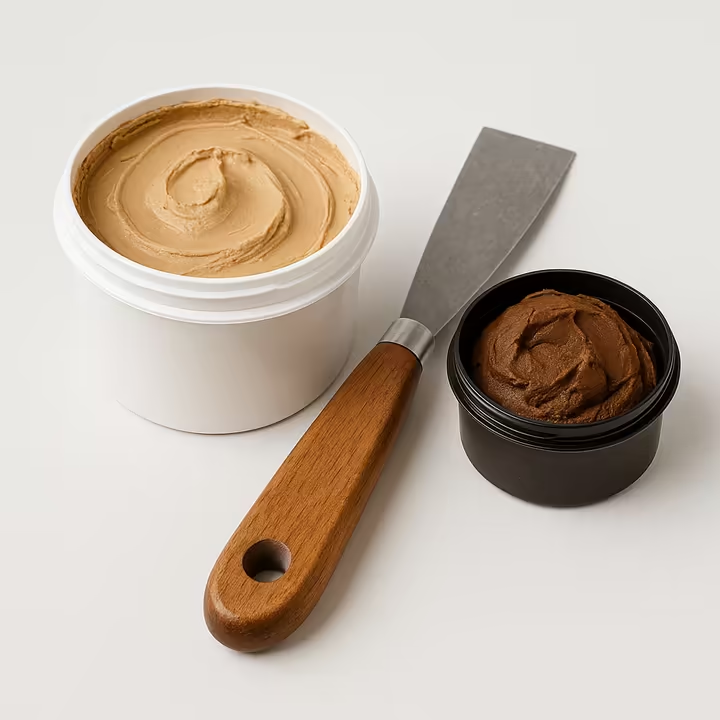
Composition and Properties
The behavior of wood fillers and putties is determined by their core ingredients. Bulking agents provide substance, while binders and suspension mediums dictate hardness, curing, and finish compatibility.
Wood Filler
Wood filler repairs imperfections like cracks and gouges in unfinished wood. It cures to a hard solid that can be sanded flush, becoming a permanent part of the wood before finishing. 1
Chemical Composition
Wood filler contains bulking agents suspended in a binder, which determines the filler's category and performance.
- Bulking Agents: Most fillers use solids like wood fibers, sawdust, or wood flour to provide volume. 8 These wood particles allow the filler to absorb stain, similar to real wood. 1 Inorganic materials like silica, limestone, or gypsum may be added to improve density and sandability. 13
- Binders and Suspension Mediums: The binder hardens and adheres the bulking agents to the wood. Common types include water-based (latex/acrylic), solvent-based (petroleum/lacquer), and two-part epoxy/polyester systems. 8
Curing Mechanism
The hardening method depends on the binder system.
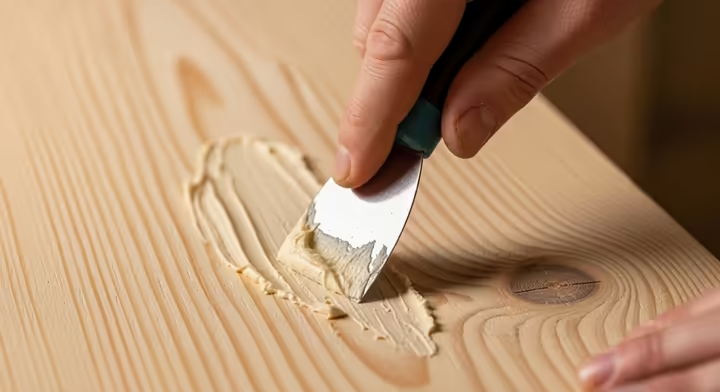
- Evaporative Drying: Water-based and solvent-based fillers cure as their suspension medium, either water or a chemical solvent, evaporates. This process draws the binder and bulking agents together into a solid mass. 18
- Chemical Curing: Two-part epoxy and polyester fillers cure through an irreversible chemical reaction between the resin and a hardener. This process is independent of evaporation, allowing for a faster, more predictable cure. 25
Physical Properties and Packaging
Wood fillers are sold as thick pastes in tubs, tubes, or two-part kits. 15, 20 The product is overfilled slightly to account for shrinkage and allow for sanding to a flush surface. 1
Wood Putty
Wood putty is a cosmetic product for minor touch-ups on finished surfaces. Its formula prioritizes flexibility and color matching over structural strength. 1
Chemical Composition
Wood putty contains no wood fibers and uses a non-hardening base. It is typically a pliable, oil-based or synthetic compound containing oils, calcium carbonate, and color pigments. 6, 31
Curing Mechanism
Wood putty is formulated to be non-hardening . 1 It remains permanently soft and pliable, though its surface may form a skin over time. 1 This flexibility allows it to accommodate wood's natural expansion and contraction without cracking. 1
Physical Properties and Packaging
Wood putty is sold as a dense, clay-like material in small tubs or as crayon-like sticks. 1 It comes pre-colored to match common wood stain tones. 3 Application involves pressing the putty into a defect and wiping the excess cleanly from the finished surface. 1
At-a-Glance Comparison
| Attribute | Wood Filler | Wood Putty |
|---|---|---|
| Application Stage | Pre-finish (on bare or primed wood) | Post-finish (on stained, painted, or sealed wood) |
| Composition Base | Wood fibers/minerals in a water-, solvent-, or epoxy-based binder 8 | Oil-based or plastic compounds with pigments; no wood fibers 6 |
| Curing Mechanism | Hardens via evaporation or chemical reaction 18 | Non-hardening; remains pliable, may form a surface skin 3 |
| Final State | Hard, rigid, structural 1 | Soft, flexible, non-structural 1 |
| Sandable | Yes, designed to be sanded flush 1 | No, sanding will smear the material and damage the finish 31 |
| Stainable | Yes (performance varies by fiber content) 1 | No, non-porous base repels stain 2 |
| Paintable | Yes, after sanding and priming 15 | Yes (some types), after skinning over; may require oil primer 31 |
| Primary Use | Repairing gouges, cracks, and holes in unfinished wood 1 | Filling nail holes and minor scratches in finished wood 1 |
| Common Formats | Tubs, squeeze tubes, two-part kits 17 | Small tubs, crayon-like sticks 1 |
Performance Characteristics
The compositional differences between wood filler and putty lead to distinct performance characteristics. Selecting the correct product depends on the project's structural and aesthetic requirements.
Hardness, Sandability, and Structural Integrity
Wood filler hardens to integrate with the wood, while wood putty remains soft for cosmetic use.
- Wood Filler: Once cured, wood filler becomes a hard, dense solid that can be sanded, drilled, planed, and cut. 17 Two-part epoxy fillers cure to a very high hardness, providing structural reinforcement. 24 They can both fill voids and rebuild missing sections of wood, providing a strong anchor for fasteners. 15
- Wood Putty: Wood putty remains permanently soft and is never sanded, as this would smear the material across the surrounding finish. 3 It offers no structural integrity and cannot hold fasteners. 38 Its purpose is aesthetic concealment.
Flexibility and Durability
A product's durability is relative to its ability to handle environmental stress, primarily dimensional changes in wood from temperature and humidity shifts.
- Wood Filler: One-part fillers cure to a rigid state, making them prone to cracking or delaminating when the surrounding wood moves. 1 For this reason, they are best for stable, interior conditions. 1 Two-part epoxies are more flexible and form a tenacious bond, allowing them to move with the wood and providing excellent durability in exterior environments. 22
- Wood Putty: Wood putty's permanent flexibility is its key advantage. It maintains a tight seal in small voids like nail holes despite seasonal wood movement. This makes it the superior choice for cosmetic repairs on finished exterior surfaces like siding and trim. 1
Paint and Stain Compatibility
A product's ability to accept a finish is determined by its chemical composition and cured state.
- Wood Filler: Most wood fillers are both stainable and paintable. 1 Stain absorption depends on the filler's wood fiber content; however, a perfect color match is difficult to achieve. 10, 20 All hardened fillers are paintable after being sanded smooth and coated with a primer, which ensures a uniform finish. 21
- Wood Putty: Wood putty is not stainable. 1 Its non-porous base prevents stain penetration, so it is applied after staining and is sold in pre-colored shades to match finishes. 3 Some "painter's putty" can be painted after it forms a surface skin, but it may require an oil-based primer to prevent oils from bleeding through the topcoat. 31
Practical Application Guide
Choosing the right product requires matching its properties to the repair scenario. The correct choice depends on the project stage, location, defect size, and material.
Interior Applications
Interior woodwork requires solutions for both preparing new installations and touching up finished pieces.
- New, Unfinished Trim (Paint-Grade): For filling nail holes in new, unpainted trim, a water-based wood filler is standard due to its low odor, fast drying, and sandability. 12, 15 Overfill holes, sand smooth, prime, and paint.
- Repairing Existing Painted Trim: To fill a hole in already painted trim, use a paintable, oil-based painter's putty. 31 Press the soft putty into the hole, slice off the excess cleanly, and touch up the spot with paint after the putty skins over. No sanding is needed.
- Minor Repair on Stained Furniture (Finished): To conceal a small defect on a finished piece of furniture, a color-matched, non-hardening wood putty is the only correct choice. 3 The putty is applied as the final step to cosmetically hide the blemish.
- Major Repair on Furniture (Unfinished/Stripped): For significant damage like a shattered corner on a stripped piece of furniture, a two-part epoxy filler is required. 6 It provides the structural strength to rebuild the damaged area, which can then be shaped, sanded, and refinished. 20
Exterior Applications
Exterior products must withstand moisture and temperature fluctuations that cause wood to expand and contract. 33
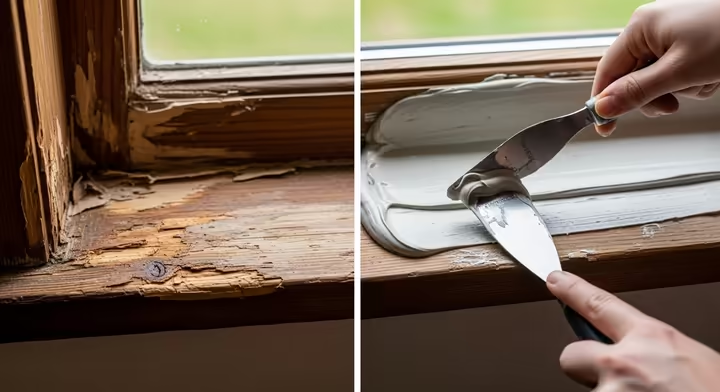
- Large, Structural, and Rotted Wood Repairs: This is the exclusive domain of two-part epoxy fillers, as standard fillers will fail outdoors. 1, 22 For rot, first remove all decayed wood, apply a liquid epoxy consolidant to strengthen the remaining fibers, then use the epoxy filler to rebuild the area. The cured repair is waterproof and durable. 20, 22
- Cosmetic Repairs on Painted Exterior Surfaces: For filling nail holes in painted exterior trim or siding, a flexible, non-hardening wood putty is best due to its ability to accommodate wood movement. 1, 31
Flooring Repairs
The correct product depends on whether the floor is being installed or is already finished.
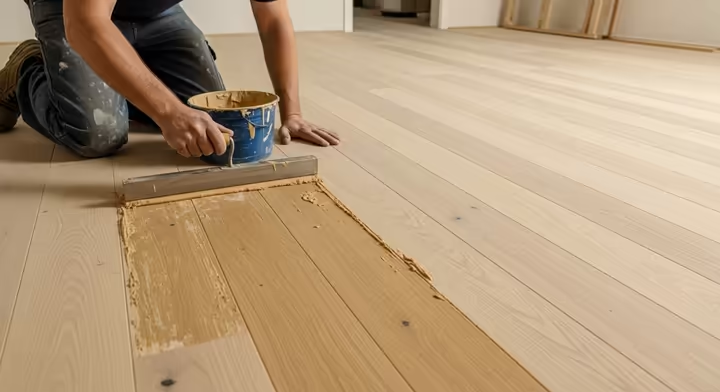
- Unfinished Hardwood Floor Installation/Refinishing: During a full sand-and-finish job, professionals use a trowelable wood filler across the entire surface to fill gaps between boards. 7 Once dry, the excess is removed during the floor sanding process, creating a uniform surface for finishing. 52
- Scratches in a Finished Floor: To repair a minor defect in a finished floor without damaging the surface, use a color-matched, non-hardening putty stick. 1 Rub the putty into the scratch and buff off the excess with a clean cloth.
Substrate Compatibility
- Solid Wood and MDF: Both wood filler and putty are suitable for solid wood. For MDF that will be painted, a standard wood filler is effective.
- PVC Trim: PVC is a plastic with a high rate of thermal expansion. Use fillers and adhesives specifically formulated for PVC, such as two-part acrylics, which bond to the plastic and remain flexible. 24
Product Selection Matrix
| Repair Scenario | Recommended Product Type | Key Rationale | Example Brands |
|---|---|---|---|
| Nail holes in new, unpainted interior trim | Water-Based Wood Filler | Low odor, sandable, paintable 12 | Elmer's ProBond, DAP Plastic Wood-X |
| Gouge in a finished oak table | Color-Matched Wood Putty | Post-finish, non-sanding, cosmetic fix 3 | Minwax Wood Putty, DAP Plastic Wood Putty |
| Rotted exterior window sill | Two-Part Epoxy Filler (with Wood Hardener) | Structural, waterproof, weather-resistant, durable 22 | Abatron WoodEpox, Minwax High Performance, Bondo |
| Gaps in unfinished hardwood floor (full refinish) | Trowelable Wood Filler | Fills entire surface, sands off with floor, pre-finish 33 | DuraSeal Trowelable Wood Filler, Woodwise Wood Patch |
| Nail holes in painted exterior siding | Exterior-Rated Painter's Putty | Flexible for wood movement, paintable, post-finish 1 | DAP '53' Professional Painter's Putty |
| Stripped screw hole in a door hinge | Two-Part Epoxy Filler or DIY Glue/Sawdust | Hardens to hold new threads, structural strength 20 | KwikWood, Bondo, Homemade |
| Minor scratch on a polyurethane-coated floor | Color-Matched Putty Stick | Cosmetic, non-sanding, does not damage finish 1 | Minwax Putty Stick, Guardsman Filler Sticks |
| Filling nail holes in white PVC trim | PVC-Specific Cellular Filler | Bonds to plastic, remains flexible for thermal expansion 24 | PVC trim cements, Two-part acrylic fillers |
Application, Troubleshooting, and Safety
A successful repair requires correct product selection, proper application technique, and an understanding of safety protocols.
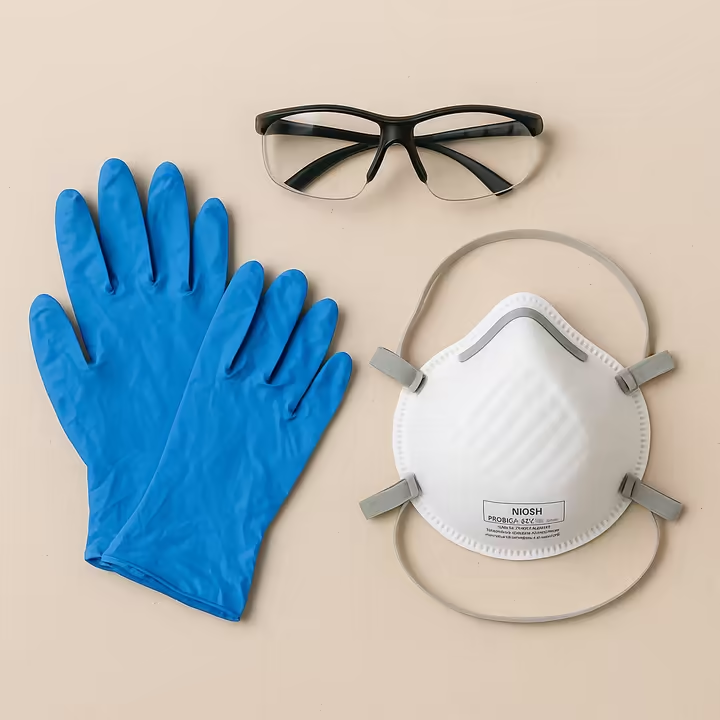
Application Methods and Troubleshooting
Proper technique is critical for a durable and invisible repair.
- Surface Preparation: The wood surface must be clean, dry, and free of contaminants. 17 For rotted wood, remove all decayed fibers until only solid wood remains. Proper preparation ensures a strong bond and prevents future rot. 20
- Application Techniques: For wood filler, use a putty knife to press the material firmly into the defect and slightly overfill it. For any repair deeper than 1/4 inch, apply the filler in thin layers, allowing each to dry completely. 17 For wood putty, press it into the defect and use a sharp knife to slice off the excess flush with the surface, then immediately wipe away any residue. 3
- Working and Curing Times: Cure times vary by product type, repair depth, and ambient conditions. 10 Two-part epoxies have a short working time (3-15 minutes) and can often be sanded in 15-30 minutes. 20 Water-based fillers can take 2-36 hours to dry, while oil-based putties remain soft but form a paintable skin in 24-48 hours. 15, 10
- Troubleshooting Common Problems: Filler cracking is caused by applying it too thickly or using a rigid filler in an area with wood movement. 33 Putty smudges or "halos" occur when residue is left on the finish; prevent this by wiping the area clean immediately after application. 45 Paint "flashing" (a difference in sheen) is prevented by applying primer over the sanded filler before painting. 21
Health, Safety, and Environmental Considerations
These products contain chemicals that require safety protocols and proper disposal.
- Volatile Organic Compounds (VOCs): Solvent-based and two-part fillers contain high levels of VOCs and should only be used in well-ventilated areas. 13, 58 Water-based fillers are low-VOC or zero-VOC, making them a safer choice for interior work. 17, 59
- Personal Protective Equipment (PPE): Wear chemical-resistant gloves and safety glasses when working with fillers or putties. 20 A NIOSH-approved respirator or dust mask is essential during sanding to avoid inhaling harmful dust. 46
- Proper Disposal: Unused solvent-based and two-part fillers are often classified as household hazardous waste and must be disposed of at a designated facility. 58, 64 Never discard them in regular trash or down drains. 58 Check local regulations, as some products may be disposed of in household trash once fully hardened. 69
Market and Cost Analysis
Market trends focus on safety and performance, influencing product cost and value. A product's true value depends on its coverage, shelf life, and long-term performance.
New Technologies
- Solvent-Free and Zero-VOC Formulations: There is a strong trend toward high-performance fillers with low or zero VOCs. These products offer professional-grade durability without the hazardous fumes of older formulas, making them safer for interior use. 59, 60
- UV-Cure Fillers: UV-curable fillers, primarily used in industrial settings, are 100% solids with no solvents to evaporate. They cure in seconds when exposed to a high-intensity UV light, resulting in zero shrinkage and a hard, durable surface. 72, 73
Cost and Value
- Price and Coverage: Wood putty is generally cheaper per ounce than wood filler. 10 Within the filler category, water-based products are most economical, while high-performance two-part epoxies are more expensive but offer extreme durability for critical repairs. 76, 28
- Shelf Life and Waste: Water-based fillers are prone to drying out, though some can be reconstituted with water. 18 Two-part epoxies and oil-based putties have an excellent shelf life as long as their containers are sealed properly. 59
- Overall Value: For small DIY projects, an inexpensive water-based filler or putty stick offers the best value. For professionals, value is measured in time savings and reliability, making fast-curing or highly durable products a worthwhile investment. 4, 28
Conclusion: Summary for a House-Painting Project
For a typical house-painting project, your choice depends on the timing. Before painting, use a water-based wood filler to fill holes in bare or primed wood. Sand it smooth, then prime and paint for a durable, invisible repair.
If you find a small hole after you have already painted, do not use filler, as sanding would ruin the new finish. Instead, use a white, paintable painter's putty . Press it into the hole, wipe away the excess, and touch up the spot with your trim paint for a quick, clean fix.
Works cited
- Wood Filler vs. Wood Putty: What's the Difference? - The Spruce, https://www.thespruce.com/wood-filler-vs-wood-putty-7553299
- www.thespruce.com, https://www.thespruce.com/wood-filler-vs-wood-putty-7553299#:~:text=Wood%20filler%20is%20intended%20for,t%20be%20sanded%20or%20stained.
- Minwax® Wood Putty, https://www.minwax.com/en/products/maintenance-repair-tools/wood-putty
- Deciding on Wood Fillers - Fine Homebuilding, https://www.finehomebuilding.com/project-guides/painting/deciding-on-wood-fillers
- What is the difference between Wood Putty and Wood Filler? - Ardec - Finishing Products, https://ardec.ca/en/docs/article/82-what-is-the-difference-between-wood-putty-and-wood-filler
- Wood Putty vs. Wood Filler: What's the Difference? - Bob Vila, https://www.bobvila.com/articles/wood-putty-vs-wood-filler/
- What is the difference between wood putty and wood filler? - Quora, https://www.quora.com/What-is-the-difference-between-wood-putty-and-wood-filler
- www.thisoldhouse.com, https://www.thisoldhouse.com/woodworking/23189969/wood-putty-vs-wood-filler#:~:text=Usually%2C%20a%20wood%20filler%20is,to%20achieve%20the%20desired%20consistency.
- Wood putty - Wikipedia, https://en.wikipedia.org/wiki/Wood_putty
- Wood Putty vs Wood Filler: Which To use [+FAQs] - Selleys Singapore, https://selleys.com.sg/diy-guide/wood-putty-vs-wood-filler/
- Wood Putty vs. Wood Filler: Which Should You Use? - Vintage & Specialty Wood, https://usvintagewood.com/wood-putty-vs-wood-filler-which-should-you-use/
- 7 Must-Have Wood Fillers to Upgrade Your Chipped Furniture - The Spruce, https://www.thespruce.com/best-wood-fillers-5089771
- Wood Putty vs. Wood Filler: When It's Best to Use Each - Family Handyman, https://www.familyhandyman.com/article/wood-putty-vs-wood-filler/
- en.wikipedia.org, https://en.wikipedia.org/wiki/Wood_putty#:~:text=It%20is%20often%20composed%20of,in%20addition%20to%20wood%20dust.
- All Purpose Wood Filler - technical data sheet, https://www.dap.com/media/18750/cda_dap-wood-pro_rpr_en.pdf
- Wood Filler vs Spackle: Which One You Should Use And Why - CNC Masters, https://www.cncmasters.com/wood-filler-vs-spackle/
- DAP® Premium Wood Filler - technical data sheet, https://www.dap.com/media/18920/premium-wood-filler-tdb-final-3nov20.pdf
- Working with Wood Filler - Extreme How To, https://extremehowto.com/working-with-wood-filler/
- DAP® Plastic Wood® 21408 Professional Wood Filler Golden Oak / 4 - Jackson's Hardware, https://www.jacksonshardware.com/products/dap-reg-plastic-wood-reg-21408-professional-wood-filler
- Minwax® High Performance Wood Filler, https://www.minwax.com/en/products/maintenance-repair-tools/high-performance-wood-filler
- How to Use Wood Filler - The Spruce, https://www.thespruce.com/apply-wood-putty-for-strong-bond-1822743
- DAP® PLASTIC WOOD Epoxy Filler - technical data sheet, https://www.dap.com/media/14889/plastic-wood-epoxy-filler-8-6-fl-oz-tds-final.pdf
- Bondo® Wood Filler, https://images.thdstatic.com/catalog/pdfImages/e7/e7773338-bffe-4407-8ce3-19cc8d163a32.pdf
- How To Choose and Use Wood Filler - This Old House, https://www.thisoldhouse.com/woodworking/21017152/how-to-choose-and-use-wood-filler
- Bondo® Wood Filler | 3M United States, https://www.3m.com/3M/en_US/p/d/b40069621/
- Minwax® Wood Filler - Colorbank, https://colorbank.mv/wp-content/uploads/2020/05/1237.pdf
- How To Fix Rotted Wood With Epoxy - This Old House, https://www.thisoldhouse.com/woodworking/21016843/how-to-fix-rotted-wood-with-epoxy
- See In Search of the Best Wood Filler - Painting The Craftsman Blog, https://thecraftsmanblog.com/the-7-best-products-to-patch-wood/comment-page-4/
- How thick can you apply wood filler to damaged wood? - Quora, https://www.quora.com/How-thick-can-you-apply-wood-filler-to-damaged-wood
- Finishing In Humid Weather - Rodbuilding.org, https://www.rodbuilding.org/read.php?2,368155
- DAP® Professional Painter's Putty '53' - technical data sheet, https://www.dap.com/media/19011/painter-s-putty-53-tds_5-9-19.pdf
- DAP® PLASTIC WOOD® Wood Putty - technical data sheet, https://www.dap.com/media/19042/plastic-wood-wood-putty-tds_8-7-19.pdf
- Filler Facts: Wood Filler Isn't Always the Right Solution - Rosebud Floors, https://rosebudfloors.com/2016/07/17/filler-facts-wood-filler-isnt-always-the-right-solution/
- Wood Putty vs. Wood Filler: What's the Difference? - This Old House, https://www.thisoldhouse.com/woodworking/23189969/wood-putty-vs-wood-filler
- DAP Non-Hardening Wood Putty, https://www.dap.com/products-projects/products/dap-non-hardening-wood-putty/
- Minwax Wood Putty, Golden Oak - Midwest Technology Products, https://www.midwesttechnology.com/minwax-wood-putty-golden-oak/
- How to Repair Rotted Wood (DIY) - Family Handyman, https://www.familyhandyman.com/project/how-to-repair-rotted-wood/
- Best Wood Fillers 2025 - The Only 7 You Should Consider - YouTube, https://www.youtube.com/watch?v=AHjA36xRtYQ
- Why is my wood filler cracking? : r/BeginnerWoodWorking - Reddit, https://www.reddit.com/r/BeginnerWoodWorking/comments/jihg85/why_is_my_wood_filler_cracking/
- DAP® PLASTIC WOOD-X™ ALL PURPOSE WOOD FILLER with DRYDex® Dry Time Indicator, https://es.dap.com/media/13055/plastic-wood-x-filler-tds_12-16-2019.pdf
- Best exterior wood filler? : r/paint - Reddit, https://www.reddit.com/r/paint/comments/1gz1x8t/best_exterior_wood_filler/
- Hardwood Floor Filler Repair: Top 5 Proven Techniques 2024, https://romerohardwoodfloor.com/hardwood-floor-filler-repair/
- My mom always told me sawdust and Elmer's glue made wood putty does it work? - Reddit, https://www.reddit.com/r/woodworking/comments/14qdpge/my_mom_always_told_me_sawdust_and_elmers_glue/
- Wood filler left on for over 2 years! : r/paint - Reddit, https://www.reddit.com/r/paint/comments/1l42bmk/wood_filler_left_on_for_over_2_years/
- Repairing Wood Filler Smudges - Woodweb.com, https://woodweb.com/knowledge_base/Repairing_Wood_Filler_Smudges.html
- Stainable Wood Filler - Repair Nail Holes & More | Minwax®, https://www.minwax.com/en/products/preparation/stainable-wood-filler
- Leech Superior Grade Real Wood Filler 4 oz. - Jefferson City, TN - Leeper Hardware, https://leeperhardware.com/products/leech-superior-grade-real-wood-filler-4-oz
- Whats your favorite product for filling trim nail holes? : r/paint - Reddit, https://www.reddit.com/r/paint/comments/1g1o13r/whats_your_favorite_product_for_filling_trim_nail/
- How to use painters putty. - YouTube, https://www.youtube.com/watch?v=Ctl600c-kkI&pp=0gcJCfwAo7VqN5tD
- What is a good wood filler product for exterior wood, that is white in color? - Quora, https://www.quora.com/What-is-a-good-wood-filler-product-for-exterior-wood-that-is-white-in-color
- Paintable Wood Filler - The Real Milk Paint Company, https://www.realmilkpaint.com/shop/tools-supplies/real-wood-filler/
- DuraSeal Wood Patch Wood Filler Gallon - Floor Mechanics, https://floormechanics.com/filler/duraseal-wood-patch-wood-filler-gallon/
- How to Choose and Use Wood Filler | This Old House - YouTube, https://www.youtube.com/watch?v=MHQCqnoTBXM
- Plastic Wood 3 oz. Natural Latex Wood Filler - DAP - The Home Depot, https://www.homedepot.com/p/questions/DAP-Plastic-Wood-3-oz-Natural-Latex-Wood-Filler-00580/206667338/1
- How Temperature & Humidity Impact Cure - Astro Chemical, https://astrochemical.com/how-temperature-and-humidity-impact-cure/
- BONDO WOOD FILLER - 3M, https://multimedia.3m.com/mws/media/1312140O/bondo-wood-filler-directions-for-use.pdf
- DAP Plastic Wood 32 oz. Natural Latex Wood Filler 00525 - The Home Depot, https://www.homedepot.com/p/DAP-Plastic-Wood-32-oz-Natural-Latex-Wood-Filler-00525/205337025
- Household Hazardous Waste or Not, https://www.nwrpc.com/DocumentCenter/View/46
- Rubio Monocoat Wood Filler Putty - one-component, shrink-proof fast-curing putty in powder form, https://www.greenbuildingsupply.com/products/rubio-monocoat-woodfiller-quick
- NEW Gorks Goodfilla Water Based Wood Filler, https://www.highlandwoodworking.com/gorks-goodfilla-wood-filler.aspx
- Minwax-Wood-Putty-Walnut-MINWAX-Company.pdf - SAFETY DATA SHEET, http://www.haywood.k12.nc.us/wp-content/uploads/sites/12/2016/08/Minwax-Wood-Putty-Walnut-MINWAX-Company.pdf
- Part 1: It's Just...Bondo | TRC - Retrofit Companies, https://retrofitcompanies.com/part-1-its-just-bondo/
- Wastes Banned From the Trash - CalRecycle Home Page - CA.gov, https://calrecycle.ca.gov/homehazwaste/info/
- Recycling & Household Hazardous Waste (HHW) - Freeborn County, https://www.co.freeborn.mn.us/177/Recycling-Household-Hazardous-Waste-HHW#!rc-cpage=534958
- How to dispose of or recycle Wood Putty - Dodge County, MN, https://www.co.dodge.mn.us/departments/garbage_disposal_transfer_station.php#!rc-cpage=486924
- Flammable Dap plastic wood - how to safely dispose? : r/HomeImprovement - Reddit, https://www.reddit.com/r/HomeImprovement/comments/11fk210/flammable_dap_plastic_wood_how_to_safely_dispose/
- How do I dispose of unused excess polyurethane? : r/BeginnerWoodWorking - Reddit, https://www.reddit.com/r/BeginnerWoodWorking/comments/1en9ycs/how_do_i_dispose_of_unused_excess_polyurethane/
- Proper Disposal - Keep Nebraska Beautiful, https://www.knb.org/waste-programs/household-hazardous-waste/proper-disposal/
- Used Paint Stripper Disposal (Furniture Restoration) : r/DIY - Reddit, https://www.reddit.com/r/DIY/comments/2o5y1v/used_paint_stripper_disposal_furniture_restoration/
- Timbermate Water Based Woodfiller - Osmo UK, https://osmouk.com/downloads/wood-filler-safety-data.pdf
- Sculpwood Putty | Moldable Epoxy Wood Filler Putty - System Three Resins, https://www.systemthree.com/products/sculpwood-moldable-epoxy-putty
- UV curing for wood & wood-based materials | IST METZ, https://www.ist-uv.com/en/applications/wood-flooring/wood-wood-based-materials
- CureUV WoodFix UV Curable Filler, https://www.cureuv.com/products/cureuv-woodfix-uv-curable-filler
- Polyester UV-Cure Grain Sealer - Solarez, https://solarez.com/polyester-uv-cure-grain-sealer.html
- CureUV Curable Primer for All Wood Applications, https://www.cureuv.com/products/cureuv-curable-primer-for-all-wood-applications
- What's the difference between Latex Wood Filler and Solvent Wood Filler? - Reddit, https://www.reddit.com/r/HomeImprovement/comments/hred7r/whats_the_difference_between_latex_wood_filler/